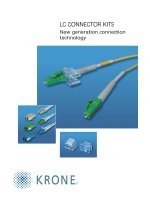Tài liệu MPLS VPN Migration Strategies doc
Bạn đang xem bản rút gọn của tài liệu. Xem và tải ngay bản đầy đủ của tài liệu tại đây (1.39 MB, 30 trang )
MPLS VPN
Migration Strategies
Overview
This chapter discusses potential migration strategies from existing IP backbones
and existing VPN solutions towards MPLS VPN solutions.
It includes the following topics:
n Infrastructure migration
n Customer migration to MPLS VPN service
Objective
Upon completion of this chapter, you will be able to design the following migration
strategies for an MPLS VPN deployment:
n Infrastructure migration strategy for existing IP backbones
n Phased migration strategy for pilot MPLS VPN service
n Migration strategy for customers using layer-2 overlay VPN solutions (Frame
Relay or ATM)
n Migration strategy for customer running layer-3 overlay VPN solutions (GRE
tunnels or IPSec)
2 MPLS VPN Migration Strategies Copyright 2000, Cisco Systems, Inc.
Infrastructure Migration
Objective
Upon completion of this section, you will be able to develop various migration
strategies away from existing backbones towards an infrastructure that supports
MPLS VPN services.
© 2000 , Cisco Systems, Inc. www.cisco.com Chapter#5-5
MPLS Infrastructure
Requirement Review
MPLS Infrastructure
Requirement Review
MPLS/VPN service requires:
• MP-BGP infrastructure to propagate VPN
routes; can be established as a separate
infrastructure
• End-to-end LDP-signaled Label Switched
Path between PE routers for MP-BGP next-
hops (usually PE router loopback interfaces)
Two basic infrastructure requirements must be satisfied to establish MPLS VPN
services in a Service Provider network:
n Multi-protocol BGP (MP-BGP) sessions must be run between Provider Edge
(PE) routers. These sessions can be established as a separate infrastructure
from the BGP sessions supporting Internet traffic to avoid any migration issues
in the network core. Please refer to Chapter 4 of this lesson for more details.
n An End-to-end Label Switched Path (LSP) must be established between the
PE routers signaled through Label Distribution Protocol (LDP) or Tag
Distribution Protocol (TDP). A LSP must be established, at least, for all next
hops of MP-BGP sessions (usually the loopback interfaces of the PE routers).
This section focuses on the migration steps needed to establish LSP between the
PE routers.
Copyright 2000, Cisco Systems, Inc. MPLS VPN Migration Strategies 3
© 2000 , Cisco Systems, Inc. www.cisco.com Chapter#5-6
MPLS Infrastructure
Establishment
MPLS Infrastructure
Establishment
Migrating existing IP backbone
• Enable MPLS in the whole backbone (Migration
from the core)
• Establish PE-PE connectivity via GRE tunnels
(Migration from the edge)
Migrating existing ATM backbone
• Enable MPLS in the whole backbone (see IP+ATM
solutions for details)
• Establish new dedicated ATM PVCs to carry
MPLS/VPN traffic
MPLS infrastructure in the network core can be established with a variety of
migration strategies. The choice of strategy depends on the layer-2 structure of the
existing network core: strategies for ATM-based cores differ from strategies for
purely router-based network cores.
In a purely router-based network core, you can choose one of two migration
strategies:
n MPLS is enabled in the whole network core (Migration from core)
n MPLS is enabled only in edge routers, resulting in disconnected islands of
MPLS connectivity. These islands are connected via IP-over-IP tunnels using
Generic Route Encapsulation (GRE) tunneling protocol (Migration from
edge)
In an ATM-based network core, you can also choose one of two migration
strategies:
n MPLS is enabled in the whole ATM network. (Migration from core). Please
refer to IP+ATM solution training for more details on this migration strategy.
n Additional Permanent Virtual Circuits (PVCs) are established directly between
islands of MPLS connectivity (Migration from edge). Existing permanent
virtual circuits can also be reused for this purpose.
Note Some service providers use single-protocol encapsulation (called AAL5MUX in
Cisco IOS) on ATM virtual circuits in their core. This encapsulation type does not
support concurrent IP and MPLS traffic and has to be changed to AAL5SNAP
encapsulation prior to MPLS deployment.
4 MPLS VPN Migration Strategies Copyright 2000, Cisco Systems, Inc.
© 2000 , Cisco Systems, Inc. www.cisco.com Chapter#5-7
Migrating from the Core
Migrating from the Core
• Core LSRs run MPLS and exchange labels
through LDP/TDP (label stack with depth = 1)
• During migration, conditional label
advertising might be configured on P- routers
in order not to distribute labels for all FECs
§ Labels are bound only to PE addresses used as
BGP next-hops
§ Conditional label advertising is easier to
configure if PE addresses are in one address
block
If you choose a Migration from Core strategy in your MPLS VPN deployment,
you have to start LDP or TDP on all core routers and configure MPLS on all core
interfaces. This operation might interfere with your existing IP traffic and you
might decide to use conditional label advertising to prevent that.
With conditional label advertising, you can distribute labels only for selected
destinations in your network (for example, only BGP next-hops of the PE routers).
The IP traffic toward the other destinations will not be labeled, as the ingress
routers would not receive labels for those destinations from their downstream
neighbors.
Note Conditional label advertising for selected destinations is easier to achieve if
these destinations are in one address block (and thus easily covered with an IP
access list). It’s therefore recommended that you assign loopback addresses of
the PE routers from one address block.
Copyright 2000, Cisco Systems, Inc. MPLS VPN Migration Strategies 5
© 2000 , Cisco Systems, Inc. www.cisco.com Chapter#5-8
Migrating from the Core
Migrating from the Core
• Edge devices will not use MPLS until the
whole core has migrated
§ IGP computes shortest path; labels are assigned
based on IGP
§ MPLS-enabled interface that is not on IGP
shortest path is NOT used
§ Need to enable MPLS in the whole core before
enabling MPLS functionality on PE routers
• Requires the complete core migration before
being able to deploy VPN-aware PE routers
There are a number of caveats associated with Migration from Core strategy:
n LDP or TDP labels are assigned solely based on the contents of an IP routing
table, which is driven by Interior Gateway Protocol (IGP) used in the network
backbone.
n If the IP routing table directs traffic toward a PE router via an interface that is
not MPLS-enabled, the label switched path toward that PE router is broken.
There is no mechanism in TDP or LDP that allows MPLS traffic to avoid non-
MPLS links if these links are in the IGP shortest path.
Note MPLS traffic could be redirected around non-MPLS-enabled parts of the network
core, even if they are on IGP shortest path, by using MPLS Traffic Engineering.
However, this solution is best avoided, as it unnecessarily increases the
network complexity.
n MPLS-enabled interfaces that are not on IGP shortest path are not used for
MPLS traffic forwarding.
In summary – when you use Migration from Core strategy, MPLS must be
enabled on all core routers and on all interfaces in the IGP shortest path between
the PE routers before you can start deploying MPLS VPN services.
6 MPLS VPN Migration Strategies Copyright 2000, Cisco Systems, Inc.
© 2000 , Cisco Systems, Inc. www.cisco.com Chapter#5-9
Migrating from the Core
Migrating from the Core
Routing issues in a partially MPLS-enabled
core:
• MPLS traffic can diverge from IGP shortest path
(Traffic Engineering)
• Non-MPLS (IP) traffic cannot diverge from IGP
shortest path
§ It’s not possible to dedicate some interfaces
only to MPLS traffic if these interfaces are also
used as shortest path for IP destinations
• No traffic splitting
Some network designers would like to deploy MPLS Traffic Engineering in
combination with the MPLS VPN services to optimize their backbone utilization.
This goal is hard to achieve in backbones where the conditional label advertising
has been implemented to minimize the impact of migration toward MPLS VPN
because:
n While MPLS VPN traffic (or other labeled traffic) can diverge from the IGP
shortest path by means of MPLS Traffic Engineering, the non-labeled traffic
(pure IP traffic) cannot. It is therefore not possible to dedicate some interfaces
to MPLS traffic (for example, additional links deployed to support MPLS VPN
service) if these interfaces happen to be on IGP shortest path toward other IP
destinations. As an intermediate step, IGP cost on these interfaces could be
increased to discourage IGP from selecting them.
n As the non-labeled traffic is forwarded based only on IP routing tables, not on
MPLS Traffic Engineering trunks established in the network core, it is hard to
achieve traffic splitting between MPLS VPN and Internet traffic without
deploying complex MPLS Traffic Engineering schemes for MPLS VPN
traffic.
Copyright 2000, Cisco Systems, Inc. MPLS VPN Migration Strategies 7
© 2000 , Cisco Systems, Inc. www.cisco.com Chapter#5- 10
Migrating from the Edge
Migrating from the Edge
• PE routers migrate directly to MPLS-VPN
§ Core does NOT run MPLS yet
• PE routers use GRE tunnels or dedicated PVCs where
MPLS is configured
§ LDP/TDP is used between PE routers across these PVCs
or tunnels
§ MPLS is supported over GRE tunnels
• Allows separation of migration issues
§ Core is not affected by PE deployment
§ Core still carries “normal” IP traffic
Migration from Edge strategy to deploying MPLS VPN services is easier and
quicker to implement, as it does not involve reconfiguration of core devices in your
network. The PE routers are MPLS-enabled and dedicated point-to-point links are
used between the PE routers (or small islands of MPLS connectivity at the edges
of the network) to enable MPLS transport across the network core. LDP or TDP
is then run over these new point-to-point links to establish Label Switched Paths
between PE routers.
The new point-to-point links needed to support MPLS connectivity across non-
MPLS backbone can be implemented with ATM Virtual Circuits in ATM-based
backbones or with IP-over-IP tunnels using Generic Route Encapsulation (GRE)
technology.
The Migration from Edge strategy enables clear separation of migration issues,
as the network core is not affected by MPLS VPN deployment and is still able to
carry non-labeled IP traffic (for example, Internet traffic).
8 MPLS VPN Migration Strategies Copyright 2000, Cisco Systems, Inc.
© 2000 , Cisco Systems, Inc. www.cisco.com Chapter#5- 11
Migrating from the Edge
Migrating from the Edge
• Migration from the edge requires GRE tunnels
or PVCs
• The number of GRE tunnels and/or PVCs
depends on the number of PE routers whether
or not any-to-any connectivity is desired
• Migration strategy relying on GRE/PVCs may
end with a large number of tunnels/PVCs
• At some point, the scalability will be limited,
and core migration will be required
The Migration from Edge strategy, while easy to implement in a pilot network,
suffers from severe scalability constraints.
The strategy requires point-to-point links between islands of MPLS connectivity.
The number of these links depends on the number of PE routers, desired traffic
pattern and potential requirement for optimal MPLS VPN traffic forwarding
across the backbone. In most cases, the end result would be a full-mesh of GRE
tunnels (or ATM virtual circuits), which is clearly not a scalable solution.
The scalability constraints of Migration from Edge strategy will eventually force
anyone deploying this strategy to revert to Migration from Core strategy once the
MPLS VPN service enters the production phase.
Note The Migration from Edge strategy also suffers from encapsulation overhead
when implemented with the GRE tunnels. Every MPLS VPN packet propagated
across the network core within a GRE tunnel incurs a 20-byte overhead of the IP
and GRE header.
Copyright 2000, Cisco Systems, Inc. MPLS VPN Migration Strategies 9
Summary
© 2000 , Cisco Systems, Inc. www.cisco.com Chapter#5- 12
Summary - Backbone
Migration Strategy
Summary - Backbone
Migration Strategy
• From the core: consistency with IGP shortest path
§ May require to limit label binding to selected addresses
§ IP traffic cannot diverge from shortest path
§ LSR does not use label if not bound by next-hops
• From the edge: requires PVCs or GRE tunnels
§ No impact on core switches
§ Possibility to re-use existing mesh where underlying ATM
is used
§ Not recommended in pure “routing” environment -
requires a mesh of GRE tunnels
There are two basic migration strategies that can be used to establish MPLS
connectivity as required by MPLS VPN service across network core:
n Migration from Core where end-to-end MPLS connectivity is established
before the MPLS VPN service is deployed. The impact of this strategy on
existing IP traffic can be minimized with deployment of conditional label
advertising, but this technique prevents you from applying additional MPLS
services (for example, MPLS Traffic Engineering) to your IP traffic.
n Migration from Edge where the small islands of MPLS connectivity on the
network edge are connected via point-to-point links. This strategy has no
impact on core switches and might be an optimal strategy in ATM
environments where the full-mesh of ATM virtual circuits is already
established between the edge routers. It should only be used for pilot projects
in the router-based backbones, as it requires a mesh of GRE tunnels in order to
enable MPLS transport across an IP backbone.
Review Questions
n How can you minimize the effect of core migration to MPLS for regular IP
traffic?
n Can you allocate labels only to PE loopback addresses if you are using an
ATM core?
n What are the benefits of edge-first migration toward MPLS infrastructure?
n What are the drawbacks of edge-first migration toward MPLS infrastructure?
n Which migration strategy is better suited for early MPLS VPN pilots?
10 MPLS VPN Migration Strategies Copyright 2000, Cisco Systems, Inc.
n Which migration strategy is better for a large-scale MPLS VPN rollout?
Copyright 2000, Cisco Systems, Inc. MPLS VPN Migration Strategies 11
Customer Migration to MPLS VPN service
Objective
Upon completion of this section, you will be able to develop migration strategies for
the following customer types:
n Customers using layer-2 overlay VPN
n Customers using layer-3 overlay VPN
n Customers using IPSec-based VPN
n Customers using L2F-based VPN
n Customers using routing protocols that are not supported as PE-CE routing
protocols
12 MPLS VPN Migration Strategies Copyright 2000, Cisco Systems, Inc.
Generic Customer Migration Strategy
© 2000 , Cisco Systems, Inc. www.cisco.com Chapter#5- 17
Generic Customer Migration
Strategy
Generic Customer Migration
Strategy
• Select central site(s) that will serve as the link
between old and new VPN services
• Deploy MPLS/VPN at the central site
• Use separate physical links or Frame Relay/ATM
subinterfaces
• Establish PE-CE routing protocol between
MPLS/VPN backbone and the central site
• Gradually migrate other sites to the MPLS/VPN
backbone
• Migrated and non-migrated sites will always be able
to communicate through the central site(s)
• New PE-CE routing protocols can be deployed during
the site migration
This section will discuss migration of existing VPN customers who might use a
variety of overlay VPN technologies, ranging from layer-2 VPNs (Frame Relay,
ATM) to IP-over-IP based overlay VPNs, toward an MPLS VPN service.
Whatever the current VPN technology, customer migration must be performed
according to the following principles:
n The migration should have minimal impact on customer connectivity and traffic
forwarding
n The migration should be performed gradually – it is impossible to migrate a
large customer in one giant step
n Each step in the migration process should be easy to test and validate
n There should be an easy and quick fallback plan for each migration step – the
customer connectivity should be easily and quickly reestablished if a particular
migration step fails
The remainder of this section provides migration examples that conform to the
principles outlined above. Each example is based on a common migration strategy
involving four broad steps adapted to the particular overlay VPN technology the
customer is using.
These are the four steps used in each of the examples:
Step 1 A site (or several sites) is selected to act as a transit site between the old and new
VPN service. All traffic between sites using the old VPN technology and sites
using the new VPN technology will flow through this transit site.









